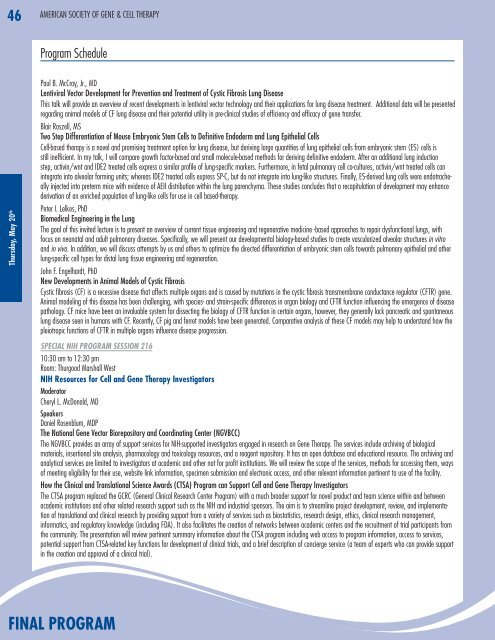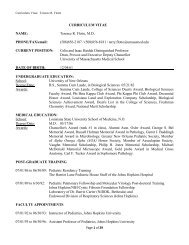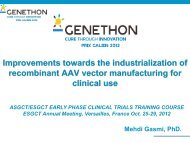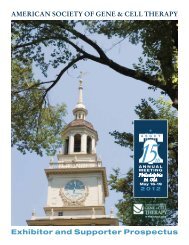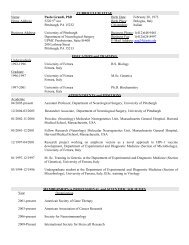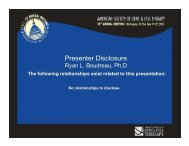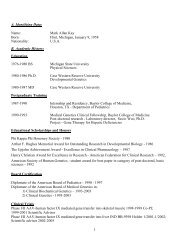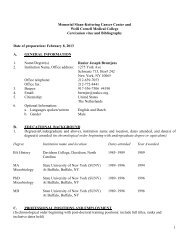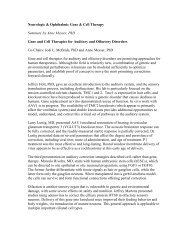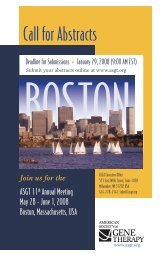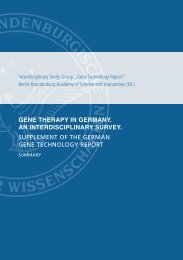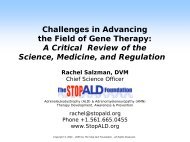FINAL PROGRAM - American Society of Gene & Cell Therapy
FINAL PROGRAM - American Society of Gene & Cell Therapy
FINAL PROGRAM - American Society of Gene & Cell Therapy
- No tags were found...
You also want an ePaper? Increase the reach of your titles
YUMPU automatically turns print PDFs into web optimized ePapers that Google loves.
46<strong>American</strong> <strong>Society</strong> <strong>of</strong> <strong>Gene</strong> & <strong>Cell</strong> <strong>Therapy</strong>Program ScheduleThursday, May 20 thPaul B. McCray, Jr., MDLentiviral Vector Development for Prevention and Treatment <strong>of</strong> Cystic Fibrosis Lung DiseaseThis talk will provide an overview <strong>of</strong> recent developments in lentiviral vector technology and their applications for lung disease treatment. Additional data will be presentedregarding animal models <strong>of</strong> CF lung disease and their potential utility in pre-clinical studies <strong>of</strong> efficiency and efficacy <strong>of</strong> gene transfer.Blair Roszell, MSTwo Step Differentiation <strong>of</strong> Mouse Embryonic Stem <strong>Cell</strong>s to Definitive Endoderm and Lung Epithelial <strong>Cell</strong>s<strong>Cell</strong>-based therapy is a novel and promising treatment option for lung disease, but deriving large quantities <strong>of</strong> lung epithelial cells from embryonic stem (ES) cells isstill inefficient. In my talk, I will compare growth factor-based and small molecule-based methods for deriving definitive endoderm. After an additional lung inductionstep, activin/wnt and IDE2 treated cells express a similar pr<strong>of</strong>ile <strong>of</strong> lung-specific markers. Furthermore, in fetal pulmonary cell co-cultures, activin/wnt treated cells canintegrate into alveolar forming units; whereas IDE2 treated cells express SP-C, but do not integrate into lung-like structures. Finally, ES-derived lung cells were endotracheallyinjected into preterm mice with evidence <strong>of</strong> AEII distribution within the lung parenchyma. These studies concludes that a recapitulation <strong>of</strong> development may enhancederivation <strong>of</strong> an enriched population <strong>of</strong> lung-like cells for use in cell based-therapy.Peter I. Lelkes, PhDBiomedical Engineering in the LungThe goal <strong>of</strong> this invited lecture is to present an overview <strong>of</strong> current tissue engineering and regenerative medicine -based approaches to repair dysfunctional lungs, withfocus on neonatal and adult pulmonary diseases. Specifically, we will present our developmental biology-based studies to create vascularized alveolar structures in vitroand in vivo. In addition, we will discuss attempts by us and others to optimize the directed differentiation <strong>of</strong> embryonic stem cells towards pulmonary epithelial and otherlung-specific cell types for distal lung tissue engineering and regeneration.John F. Engelhardt, PhDNew Developments in Animal Models <strong>of</strong> Cystic FibrosisCystic fibrosis (CF) is a recessive disease that affects multiple organs and is caused by mutations in the cystic fibrosis transmembrane conductance regulator (CFTR) gene.Animal modeling <strong>of</strong> this disease has been challenging, with species- and strain-specific differences in organ biology and CFTR function influencing the emergence <strong>of</strong> diseasepathology. CF mice have been an invaluable system for dissecting the biology <strong>of</strong> CFTR function in certain organs, however, they generally lack pancreatic and spontaneouslung disease seen in humans with CF. Recently, CF pig and ferret models have been generated. Comparative analysis <strong>of</strong> these CF models may help to understand how thepleiotropic functions <strong>of</strong> CFTR in multiple organs influence disease progression.Special NIH Program Session 21610:30 am to 12:30 pmRoom: Thurgood Marshall WestNIH Resources for <strong>Cell</strong> and <strong>Gene</strong> <strong>Therapy</strong> InvestigatorsModeratorCheryl L. McDonald, MDSpeakersDaniel Rosenblum, MDPThe National <strong>Gene</strong> Vector Biorepository and Coordinating Center (NGVBCC)The NGVBCC provides an array <strong>of</strong> support services for NIH-supported investigators engaged in research on <strong>Gene</strong> <strong>Therapy</strong>. The services include archiving <strong>of</strong> biologicalmaterials, insertional site analysis, pharmacology and toxicology resources, and a reagent repository. It has an open database and educational resource. The archiving andanalytical services are limited to investigators at academic and other not for pr<strong>of</strong>it institutions. We will review the scope <strong>of</strong> the services, methods for accessing them, ways<strong>of</strong> meeting eligibility for their use, website link information, specimen submission and electronic access, and other relevant information pertinent to use <strong>of</strong> the facility.How the Clinical and Translational Science Awards (CTSA) Program can Support <strong>Cell</strong> and <strong>Gene</strong> <strong>Therapy</strong> InvestigatorsThe CTSA program replaced the GCRC (<strong>Gene</strong>ral Clinical Research Center Program) with a much broader support for novel product and team science within and betweenacademic institutions and other related research support such as the NIH and industrial sponsors. The aim is to streamline project development, review, and implementation<strong>of</strong> translational and clinical research by providing support from a variety <strong>of</strong> services such as biostatistics, research design, ethics, clinical research management,informatics, and regulatory knowledge (including FDA). It also facilitates the creation <strong>of</strong> networks between academic centers and the recruitment <strong>of</strong> trial participants fromthe community. The presentation will review pertinent summary information about the CTSA program including web access to program information, access to services,potential support from CTSA-related key functions for development <strong>of</strong> clinical trials, and a brief description <strong>of</strong> concierge service (a team <strong>of</strong> experts who can provide supportin the creation and approval <strong>of</strong> a clinical trial).EXHIBITOR PROSPECTUSfinal program


